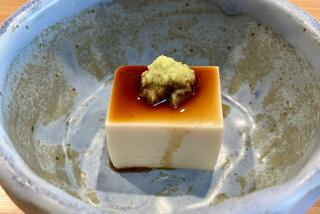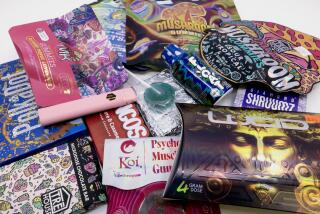The Truffle Experiments
- Share via
NAGAOKA, Japan — Truffles in a test tube? Sacre bleu!
In yet another cold-blooded assault by modern science on one of nature’s most charming and best-guarded secrets, Japanese researchers claim they have succeeded in growing a batch of white truffles in a laboratory and expect to produce a test-tube black truffle shortly.
The notion that the world’s most elusive and expensive fungi could appear year-round on supermarket shelves in little plastic foam packages has sent shivers of excitement--and horror--through the international culinary establishment.
Truffle research is still in its infancy, however. Whether Japanese planter-box truffles can ever reproduce the musty, pungent perfume of the wild, rare French and Italian varieties remains to be seen.
“I hope they cannot,” says Maurice Guillouet, executive chef at Tokyo’s premier French restaurant, Chateau Restaurant Taillevent Robuchon, which uses about 290 pounds of imported French truffles every year. “You can’t make the same thing in a laboratory as outside--the rain, the cold, the heat, the earth.”
Nevertheless, he says, “I am very curious to try it.”
The truffle is the fruit of a fungus that grows as a parasite on the roots of trees, mostly oaks. They grow around the world; China has them in abundance, and many of those eaten in France actually come from Spain. In southern France, they are harvested with the help of pigs and dogs trained to hunt them by their distinctive smell. Truffles are considered one of the world’s finest delicacies, along with foie gras and Caspian Sea caviar.
To mycologists, however, the truffle is notorious as the most finicky of fungi. The French have managed to cultivate truffles by applying spores to tree roots and raising the trees to maturity, a process that takes seven years. Kazunari Inaba, assistant professor at Kinki University in Nara, says no one has been able to get the delicate spores to propagate in a laboratory--until now.
The secret lies in the truffle’s complex nutritional requirements.
“There are seven ingredients that truffle spores like,” says Yoshinori Takano, Inaba’s collaborator at Norin Kinrui, a mushroom development company situated on a hilltop in this remote city in northwestern Japan where the successful batch of white truffles was grown. Takano, an eccentric former geologist turned mycologist, says the growing medium he and the others used included okara (the soybean chaff left over from making tofu), beech sawdust, grape sugar, nucleic acids and other vegetable extracts. When asked to elaborate, the scientist just laughed.
“You think I’m going to tell you?” Takano says. He has already applied for a patent on the process.
The researchers used white Tuber aestivum truffles imported from France, cultivating the spores in a three-stage process in the special medium for 40 days at 75 degrees. They also conducted a detailed analysis of the French soil clinging to the truffle and created a soil with the same qualities and containing the same Morcella bacteria present in the fungus’ home turf.
When a white mass of truffle spore developed, it was covered with the special soil, allowed to grow for a month, then chilled to 50 degrees for three months. The result was about 100 white truffles, Inaba says.
“When the mushroom is very hungry, it starts to propagate,” he explains. “That is why we drop the temperature, and that’s when it starts to ripen.”
However, nobody--including the researchers--has tasted the truffles.
“I hate mushrooms,” declares Takano, who insists his interest is scientific, not culinary.
Inaba says the researchers have been concentrating on nurturing the fungi through their delicate infancy and have not even begun to experiment on how to produce a tasty adult crop. Among other things, Inaba says, more experimentation is needed to figure out at what stage the truffles should be eaten.
“We have to consult a chef,” Inaba says.
Kosei Yoshida, 47, a French chef at the Kyoto Takaragaike Prince Hotel, read about Inaba’s first experimental truffles in the newspaper and rushed over to the laboratory.
“But it was too late,” he said sadly. “They were already pickled [for preservation] in alcohol, so I don’t know how good the perfume was. But if they succeed [in growing more], I really want to taste them.”
A new batch of white truffles is growing in the cool damp of Takano’s laboratory. At the moment, only several hard, white lumps the size of peas are visible. Takano says the truffles should ripen and be ready for a taste test early this year.
Meanwhile, the mycologists are working on the precious black T. melanosporum truffle, better known as the Perigord “black diamond.” They have managed to get the spores to propagate and are trying to figure out how to grow them. “We’re pretty sure now that we can do it,” Inaba says.
Takano’s cool room is crammed with beakers containing the spores of dozens of other species of rare and exotic mushrooms in various stages of fungal development. A battery of flasks marked TR-W and TR-B contains experiments on variations in the growing medium for white and black truffles. Takano’s treasure room also contains a cornucopia of Japanese mushrooms, including the beech-shimeji, eryngii, enokitake, shiitake, maitake, matsutake and the precious honshimeji.
Inaba is well known in Japan as the man who in 1991 grew the first matsutake in a bottle. The matsutake, a mushroom that grows on the roots of Japanese red pine trees, is highly prized for its fragrance and can command up to $100 for a specimen the size of a zucchini. So far, Inaba says, his cultivated matsutake have not grown bigger than a thumb. He has switched to growing them in coconut peat, however, and early results look promising, he says.
Matsutake soup is a staple of autumn cuisine at Japan’s finest restaurants. Since the demand for the mushroom far outstrips domestic supplies, Japan imports less expensive matsutake from Korea to fill the gap.
But in 1996, a matsutake crisis in Korea sent prices soaring. First, North Korea’s matsutake-producing region was beset by floods. Then a North Korean submarine ran aground off the rocky coast of South Korea in September, the middle of the mushroom season. South Korean troops on a frenzied manhunt for North Korean infiltrators shot an innocent mushroom-picker by mistake. Farmers then decided to stay safely at home, and a dearth of mushroom exports from Korea sent wholesale prices at Tokyo’s Ota vegetable market to $110 for about two pounds, double the previous year’s price.
Despite such vagaries in supply and price of wild mushrooms, many Japanese are dead set against artificial cultivation of their beloved matsutake, and they believe that truffle cultivation would be an equal travesty.
“Fall is mushroom season,” says Masae Yamaguchi, manager of the Komazen restaurant in Tokyo, which specializes in seasonal cuisine and prides itself on its matsutake dishes. “Well, this is a scientific age, so shikata ga nai,” she said: There’s nothing to be done about it. “But I feel a little sad. Mushrooms are something that come only in the autumn, and it’s a rarity of nature and that’s why it’s so nice.”
Now that Japanese have air-conditioning and central heating, live in concrete cities and eat hothouse vegetables year-round, traditionalists worry that Japan’s ancient aesthetic based on observation and appreciation of the seasons is eroding.
“If our sense of the seasons vanishes, Japanese culture will vanish,” Yamaguchi said.
The chef at Tokyo’s La Tour D’Argent restaurant in the Hotel New Otani, where truffle dishes begin with a truffle soup and end with an $18 bowl of truffle ice cream, agrees.
“Even if they could reproduce them in a lab, we would not use such truffles in this restaurant,” says Takeshi Okabe, 48. “The charm of truffles is that they are born from nature.”
Makiko Inoue of The Times Tokyo Bureau contributed to this report.






